Workout Guidance – Achieve More with Every Rep
Workout Guidance
Train Smarter, Not Harder – Workouts Tailored to Your Fitness Level & Goals
- 🏋️ Beginner Workouts – Start easy, build strength
- 💪 Strength Training – Upper body, lower body, core
- 🏃 Cardio & Endurance – Running, HIIT, cycling
- 🧘 Flexibility & Mobility – Stretching, yoga
- 🎯 Goal-Based Workouts – Fat loss, muscle gain
- 🏠 Home Workouts – No equipment, quick routines
- 💤 Recovery – Rest days, injury prevention
- 🥇 Advanced Training – Split routines, CrossFit
Beginner Workouts
Start Easy, Build Strength – Your Fitness Journey Begins Here
Starting a workout routine can feel overwhelming, but it doesn’t have to be. Beginner workouts are designed to help you build a strong foundation with simple, effective exercises that improve strength, endurance, and flexibility without overcomplicating things.
Beginner training focuses on:
- ✅ Simple Moves – Easy-to-learn exercises for all fitness levels.
- ✅ Heart Health – Light cardio to improve stamina and circulation.
- ✅ Injury Prevention – Proper form and gradual progression to avoid strain.
The key to success is consistency, not perfection. Start small, move regularly, and you’ll see improvements in strength, energy, and confidence.
Step-by-Step Beginner Workout Plan
- 📌 Start Short – Begin with 10–15 minutes a day, 3–4 times a week.
- 📌 Warm-Up – 5 minutes of brisk walking, marching in place, or light jogging.
- 📌 Basic Strength – Bodyweight squats, wall push-ups, step-ups.
- 📌 Cardio – Walking, cycling, or beginner HIIT for 5–10 minutes.
- 📌 Flexibility – Stretch after workouts to improve mobility.
- 📌 Recovery – Rest 1–2 days per week to allow muscles to repair.
- 📌 Progress Gradually – Increase workout duration or intensity slowly.
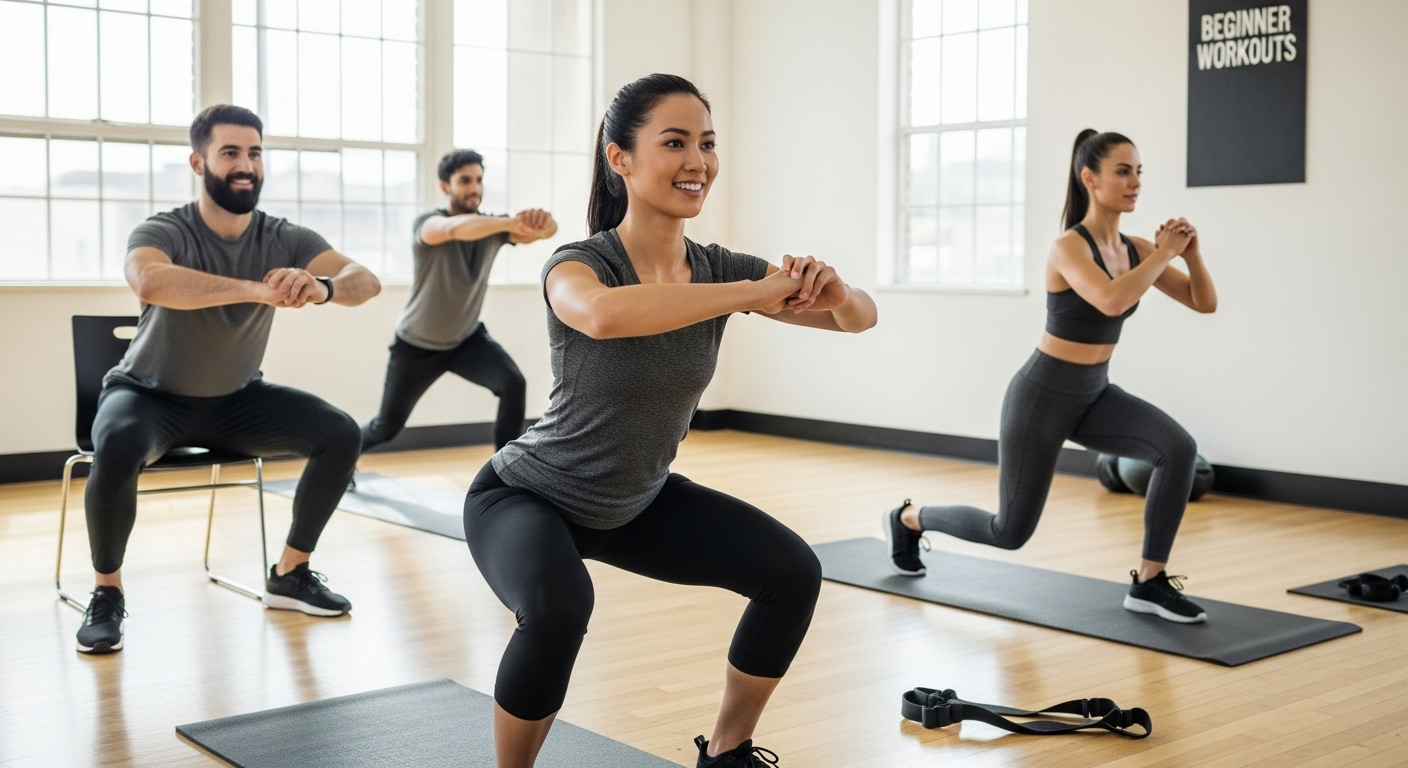
Start Easy, Build Strength
Begin Light, Stay Consistent & Grow Strong
Starting a workout routine can feel intimidating, but it doesn’t have to be. The key is to begin with simple, low-impact exercises that help your body adjust, build a foundation of strength, and reduce the risk of injury. Over time, you can increase intensity as your confidence and endurance grow.
Benefits of Starting Easy
- ✅ Protects Your Joints – Reduces strain and prevents overuse injuries
- ✅ Gradual Progress – Builds endurance and strength step-by-step
- ✅ Boosts Confidence – Achievable goals keep you motivated
- ✅ Improves Energy Levels – Supports daily activities with less fatigue
15-Minute Beginner Routine
- 📌 Warm-Up – 5 min brisk walk or marching in place
- 📌 Bodyweight Squats – 2 sets of 8–10 reps
- 📌 Wall Push-Ups – 2 sets of 8–10 reps
- 📌 Step-Ups – 2 sets of 8–10 reps per leg
- 📌 Plank Hold – 2 sets of 15–20 sec
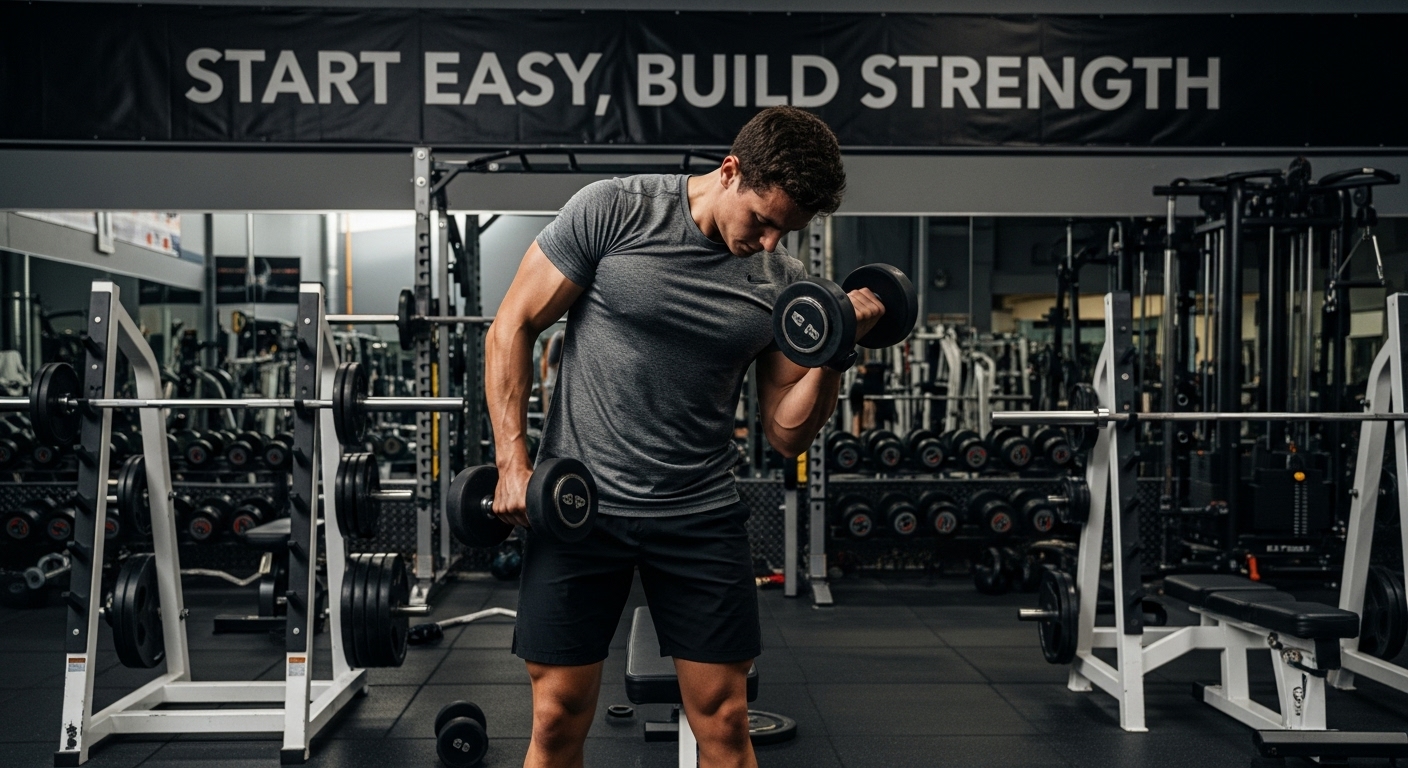
Build Strength
Increase Muscle, Power & Overall Fitness
Once you’ve built a foundation with easy workouts, it’s time to focus on building strength. Strength training not only helps you gain muscle but also improves bone density, boosts metabolism, and makes everyday activities easier.
Benefits of Strength Building
- ✅ Boosts Metabolism – Burns calories even at rest
- ✅ Improves Bone Strength – Reduces risk of osteoporosis
- ✅ Enhances Endurance – Supports cardiovascular health
- ✅ Increases Functional Strength – Makes lifting, carrying & climbing easier
Beginner Strength Training Routine (2–3x per week)
- 📌 Squats – 3 sets of 8–10 reps
- 📌 Push-Ups – 3 sets of 8–12 reps
- 📌 Rows (Resistance Band or Dumbbell) – 3 sets of 8–12 reps
- 📌 Plank Hold – 3 sets of 20–30 sec
- 📌 Lunges – 3 sets of 8–10 reps per leg
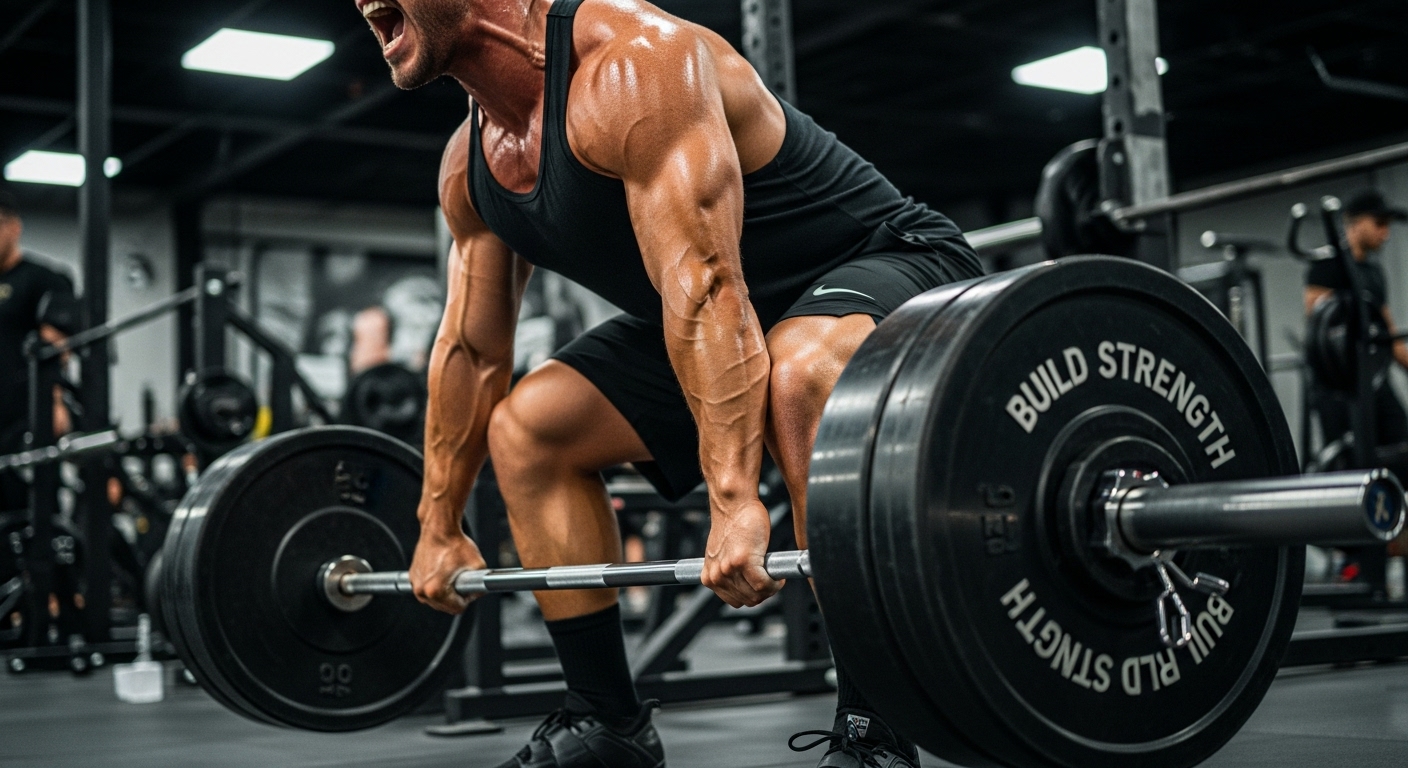
Strength Training
Build Power, Shape Your Body – One Rep at a Time
Strength training isn’t just for athletes — it’s for everyone who wants to be stronger, healthier, and more confident. It involves using resistance to challenge your muscles, which helps you gain strength, improve posture, and boost metabolism.
This category focuses on three key areas:
- ✅ Upper Body – Strengthens arms, chest, shoulders, and back.
- ✅ Lower Body – Builds powerful legs, hips, and glutes.
- ✅ Core – Improves stability, balance, and overall body strength.
Whether you use dumbbells, resistance bands, or your own body weight, strength training is essential for a strong, functional body.
Step-by-Step Beginner Strength Training Plan
- 📌 Warm-Up – 5–10 minutes of light cardio and dynamic stretches.
- 📌 Upper Body – Push-ups, dumbbell presses, rows, and bicep curls.
- 📌 Lower Body – Squats, lunges, calf raises, and glute bridges.
- 📌 Core – Planks, leg raises, bicycle crunches, and mountain climbers.
- 📌 Sets & Reps – 2–3 sets of 10–15 reps for each exercise.
- 📌 Rest & Recover – 48 hours between training the same muscle group.
- 📌 Progress – Gradually increase weight or resistance as you get stronger.
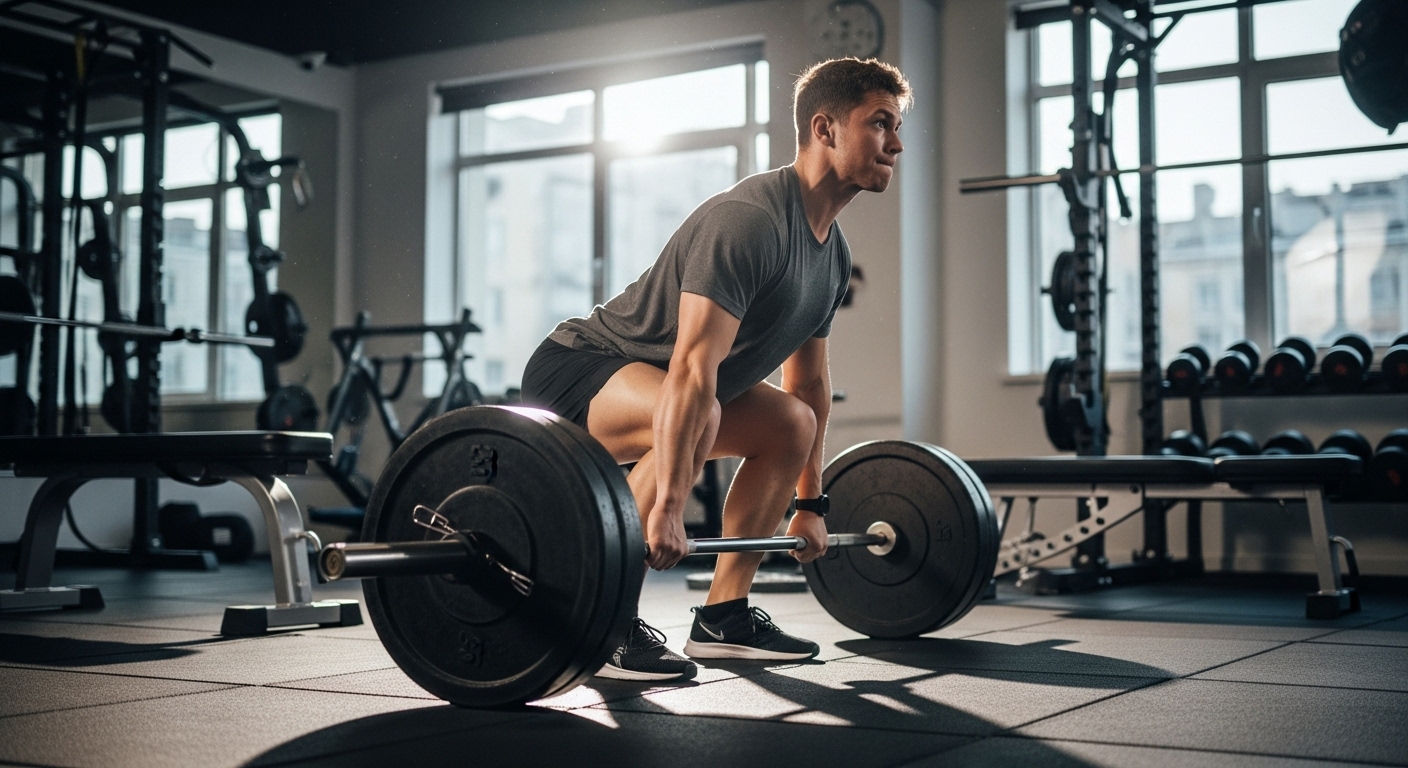
Upper Body Workouts
Build Strength & Definition – From Shoulders to Chest and Arms
Upper body workouts help strengthen your chest, back, shoulders, arms, and core. They improve posture, boost strength for everyday tasks, and create a balanced, athletic look. Whether you’re aiming for muscle definition, strength, or functional power, these exercises are key for a well-rounded fitness routine.
Key Focus Areas
- ✅ Chest – Push-ups, bench press, chest flys
- ✅ Shoulders – Overhead press, lateral raises, front raises
- ✅ Arms – Bicep curls, tricep dips, hammer curls
- ✅ Back – Pull-ups, rows, lat pulldowns
Step-by-Step Upper Body Workout Plan
- 📌 Warm-Up – 5 min of arm circles, band pull-aparts, light push-ups
- 📌 Chest – 3 sets × 10–12 reps bench press or push-ups
- 📌 Back – 3 sets × 8–10 reps rows or pull-ups
- 📌 Shoulders – 3 sets × 12 reps overhead press
- 📌 Arms – 2–3 sets × 12–15 reps curls and tricep dips
- 📌 Cool Down – Stretch shoulders, chest, and arms for flexibility
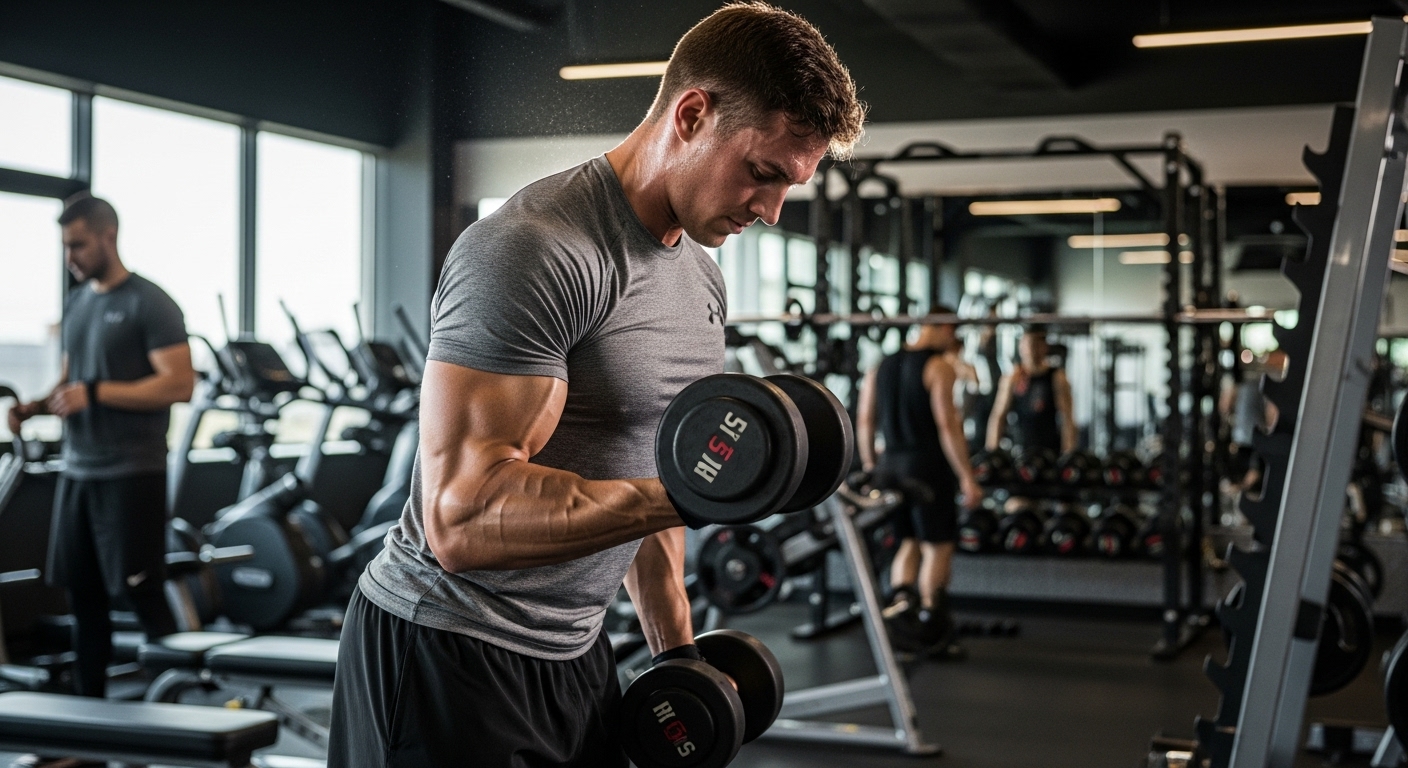
Lower Body Workouts
Build Strength, Power & Stability – From Glutes to Calves
Lower body workouts target your glutes, hamstrings, quads, and calves while improving overall stability and balance. Strong legs are essential for daily movement, athletic performance, and preventing injuries. These exercises also help burn calories and support total-body strength.
Key Focus Areas
- ✅ Quads – Squats, lunges, step-ups
- ✅ Hamstrings – Deadlifts, hamstring curls, glute bridges
- ✅ Glutes – Hip thrusts, Bulgarian split squats
- ✅ Calves – Calf raises, jump rope
Step-by-Step Lower Body Workout Plan
- 📌 Warm-Up – 5–7 min brisk walk, bodyweight squats, dynamic lunges
- 📌 Squats – 3 sets × 10–15 reps (bodyweight or weighted)
- 📌 Deadlifts – 3 sets × 8–10 reps
- 📌 Glute Bridges – 3 sets × 12–15 reps
- 📌 Calf Raises – 3 sets × 15–20 reps
- 📌 Cool Down – Stretch quads, hamstrings, and calves for 5 min
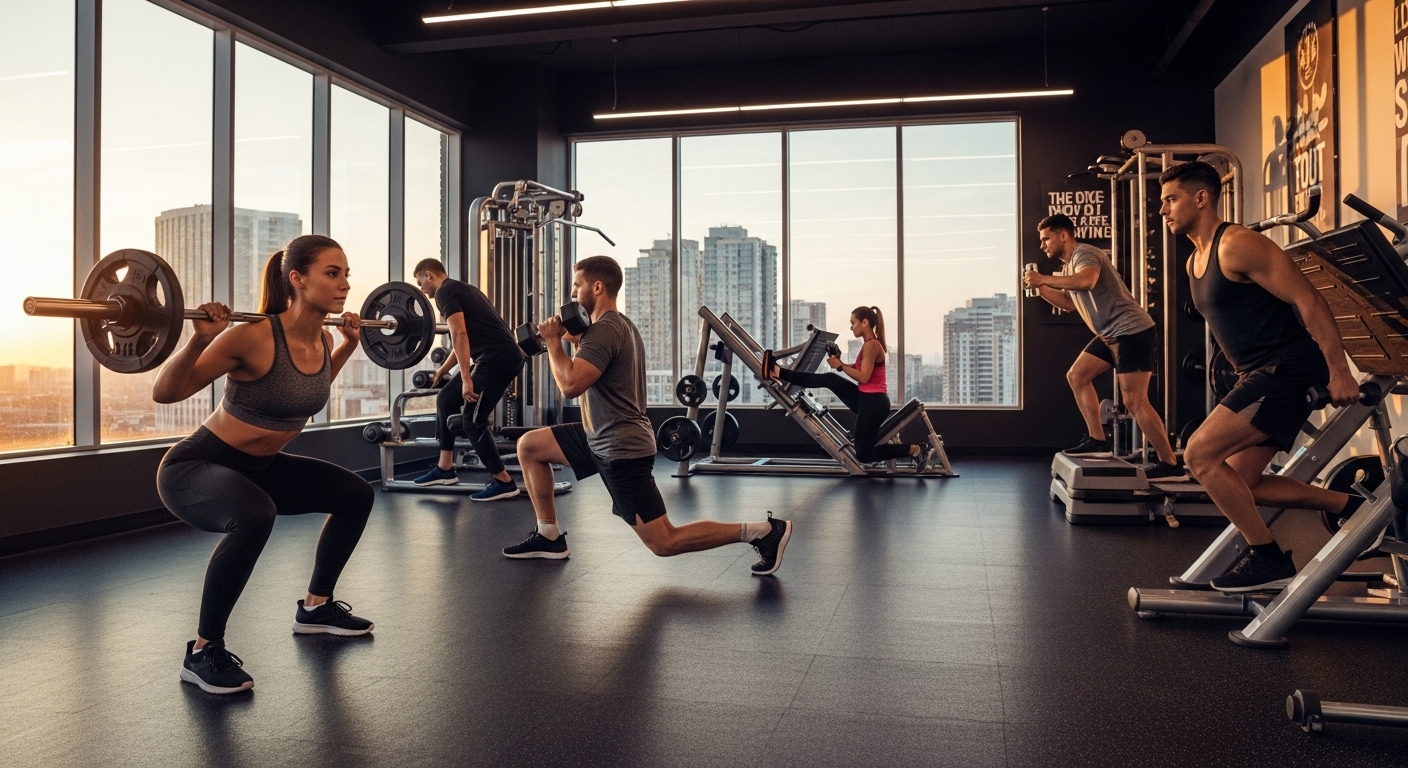
Core Workouts
Strengthen Your Center – The Powerhouse for Every Move
Core workouts target the muscles in your abdomen, lower back, and pelvis. A strong core improves balance, stability, posture, and athletic performance. It’s not just about abs – your core supports every movement you make.
Key Focus Areas
- ✅ Rectus Abdominis – Crunches, sit-ups, leg raises
- ✅ Obliques – Side planks, Russian twists
- ✅ Transverse Abdominis – Planks, hollow body holds
- ✅ Lower Back – Superman holds, bird-dogs
Step-by-Step Core Workout Plan
- 📌 Warm-Up – 3–5 min light cardio + dynamic stretches
- 📌 Plank – Hold 30–60 sec × 3 sets
- 📌 Russian Twists – 3 sets × 15–20 reps each side
- 📌 Leg Raises – 3 sets × 10–12 reps
- 📌 Superman Hold – Hold 20–30 sec × 3 sets
- 📌 Cool Down – Stretch abs, lower back, and hip flexors
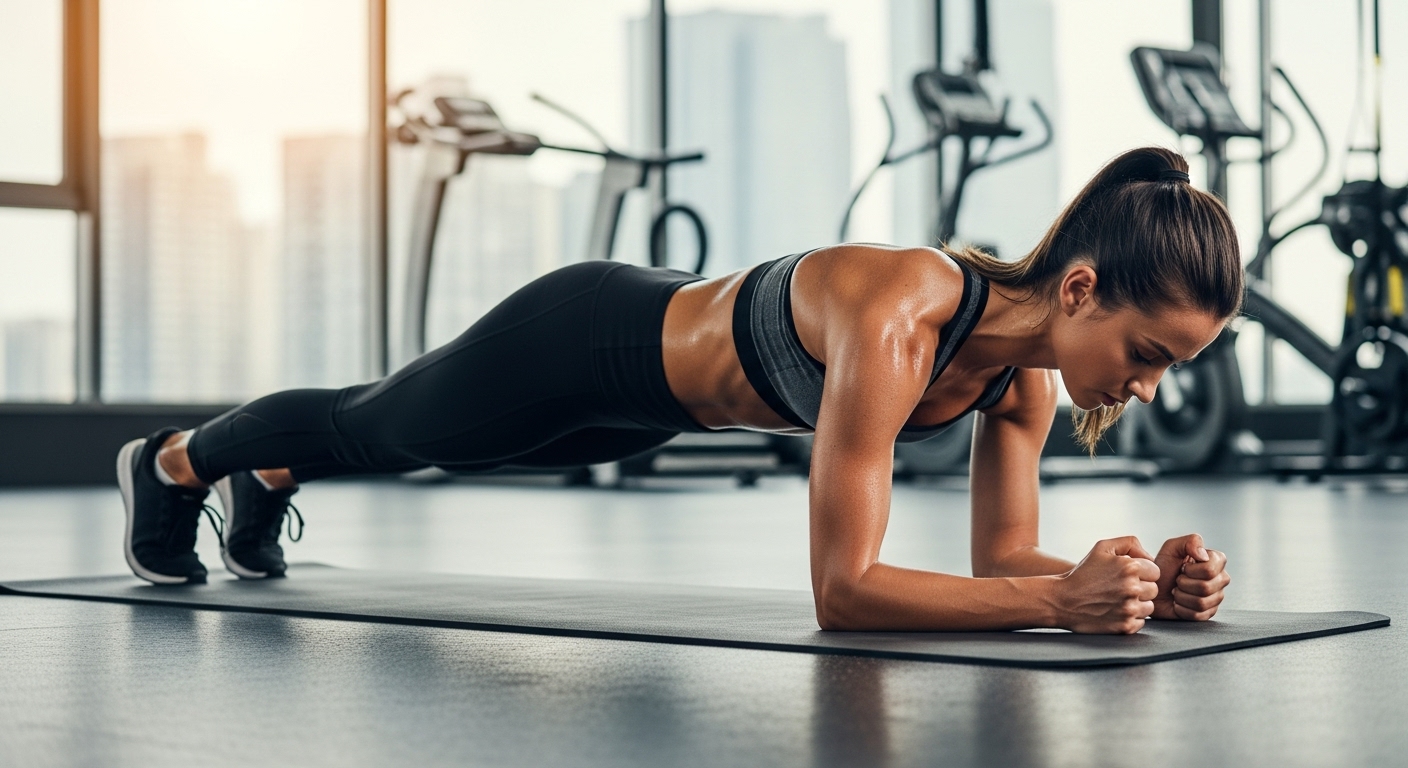
Cardio & Endurance
Boost Your Heart, Build Your Stamina – One Step at a Time
Cardio and endurance training strengthen your heart, lungs, and muscles while boosting energy and overall fitness. From steady-paced runs to high-intensity intervals, cardio helps improve stamina, burn calories, and enhance overall well-being.
This category focuses on three key approaches:
- ✅ Running – Great for cardiovascular health, endurance, and fat loss.
- ✅ HIIT – High-Intensity Interval Training for maximum results in minimal time.
- ✅ Cycling – Low-impact cardio that builds leg strength and endurance.
Whether you prefer long steady sessions or quick bursts of effort, cardio training is an essential part of a balanced fitness routine.
Step-by-Step Cardio & Endurance Plan
- 📌 Warm-Up – 5–10 minutes of brisk walking, dynamic stretches, or light jogging.
- 📌 Running – Start with 10–20 minutes at an easy pace, gradually increasing time and distance.
- 📌 HIIT – Alternate between 20–40 seconds of high effort and 1–2 minutes of rest for 10–15 minutes.
- 📌 Cycling – Ride for 20–40 minutes at a moderate pace, mixing in short bursts of higher effort.
- 📌 Frequency – Aim for 3–5 cardio sessions per week.
- 📌 Listen to Your Body – Gradually increase intensity while avoiding overtraining.
- 📌 Track Progress – Use a fitness watch or app to monitor time, pace, and distance.

Running Workouts
Boost Endurance, Burn Calories, and Strengthen Your Heart
Running is one of the most effective cardio workouts for improving cardiovascular health, building endurance, and burning calories. Whether you're jogging for general fitness or training for a race, running improves lung capacity, strengthens your legs, and enhances mental clarity.
Benefits of Running
- ✅ Cardiovascular Health – Strengthens heart and lungs
- ✅ Calorie Burn – Burns up to 600+ calories per hour
- ✅ Mental Health – Reduces stress and boosts mood
- ✅ Endurance – Improves stamina for sports and daily activities
Beginner to Intermediate Running Plan
- 📌 Warm-Up – 5 min brisk walk or light jog
- 📌 Start Easy – 1–2 min run / 1 min walk (repeat 6–8 times)
- 📌 Build Distance – Gradually increase continuous running time weekly
- 📌 Add Variety – Include hill runs or interval sprints once per week
- 📌 Cool Down – 5 min walk + stretching for calves, hamstrings, and hips

HIIT – High-Intensity Interval Training
Burn More in Less Time – Short Bursts of Effort with Big Results
HIIT combines short bursts of intense activity with brief recovery periods to maximize calorie burn, improve cardiovascular health, and build muscular endurance. It’s a time-efficient workout that can be done anywhere – no gym required.
Benefits of HIIT
- ✅ Max Calorie Burn – Burns more calories in less time
- ✅ Heart Health – Improves cardiovascular endurance
- ✅ Time-Saving – Effective workouts in 15–30 minutes
- ✅ Metabolic Boost – Keeps burning calories even after workout
Beginner HIIT Routine (No Equipment)
- 📌 Warm-Up – 3–5 min dynamic stretches + light jogging
- 📌 20 sec Sprint – Run or do high knees as fast as possible
- 📌 40 sec Rest – Walk or slow march
- 📌 Repeat 8–10 Times – Increase reps as you progress
- 📌 Cool Down – 3–5 min stretching for hamstrings, quads, and calves

Cycling
Pedal Your Way to Fitness, Fun & Freedom
Cycling is a low-impact, high-reward cardio workout that strengthens your legs, boosts endurance, and improves heart health. Whether outdoors or on a stationary bike, it’s a great way to burn calories while enjoying the ride.
Benefits of Cycling
- ✅ Heart Health – Strengthens your cardiovascular system
- ✅ Endurance Boost – Builds stamina for long activities
- ✅ Low-Impact – Gentle on joints compared to running
- ✅ Mental Well-being – Relieves stress and boosts mood
Beginner to Intermediate Cycling Plan
- 📌 Beginner – 20–30 min, 2–3 times/week at a comfortable pace
- 📌 Intermediate – 30–60 min, 3–4 times/week, mix flat and hill rides
- 📌 Advanced – Interval sessions with sprints for max performance

Flexibility & Mobility
Move Freely, Prevent Injuries – Keep Your Body in Motion
Flexibility and mobility training improves your range of motion, reduces stiffness, and helps prevent injuries. It’s an essential part of fitness that supports strength training, cardio, and daily activities.
This category focuses on two main practices:
- ✅ Stretching – Lengthens muscles, improves flexibility, and eases tension.
- ✅ Yoga – Combines flexibility, strength, and mindfulness in one practice.
By adding regular stretching or yoga into your routine, you’ll move better, feel lighter, and recover faster from workouts.
Step-by-Step Flexibility & Mobility Plan
- 📌 Warm-Up First – Do light cardio before stretching to loosen muscles.
- 📌 Dynamic Stretching – Before workouts, use leg swings, arm circles, and gentle twists.
- 📌 Yoga Sessions – Include 20–30 minutes of beginner-friendly yoga poses 2–3 times per week.
- 📌 Post-Workout Stretch – Hold each stretch for 15–30 seconds to improve flexibility.
- 📌 Daily Mobility Work – Spend 5–10 minutes on mobility drills, especially for hips and shoulders.
- 📌 Relax & Recover – Use deep breathing and relaxation stretches before bed.
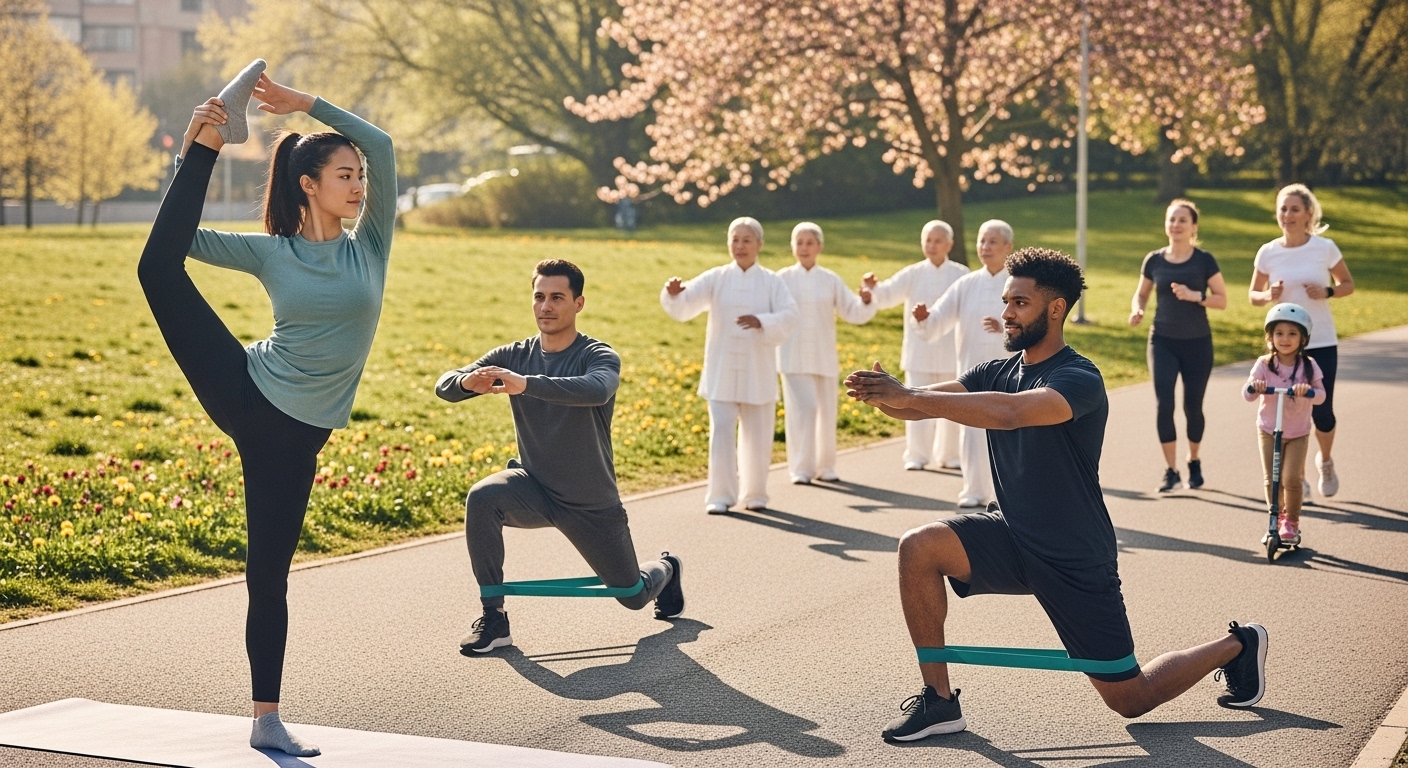
Stretching
Improve Flexibility, Reduce Stiffness & Boost Recovery
Stretching keeps your muscles flexible, strong, and healthy. Regular stretching improves your range of motion, reduces muscle tension, and helps prevent injuries. Whether after a workout or as a daily habit, stretching keeps your body moving comfortably.
Benefits of Stretching
- ✅ Flexibility – Increases muscle length and joint range of motion
- ✅ Relaxation – Relieves stress and promotes calmness
- ✅ Recovery – Helps muscles recover after workouts
- ✅ Injury Prevention – Reduces risk of strains and sprains
Daily Stretching Routine (Full Body)
- 📌 Neck Stretch – 20 sec per side
- 📌 Shoulder Stretch – 20 sec per arm
- 📌 Forward Fold – 20–30 sec for hamstrings
- 📌 Quad Stretch – 20 sec per leg
- 📌 Calf Stretch – 20 sec per side
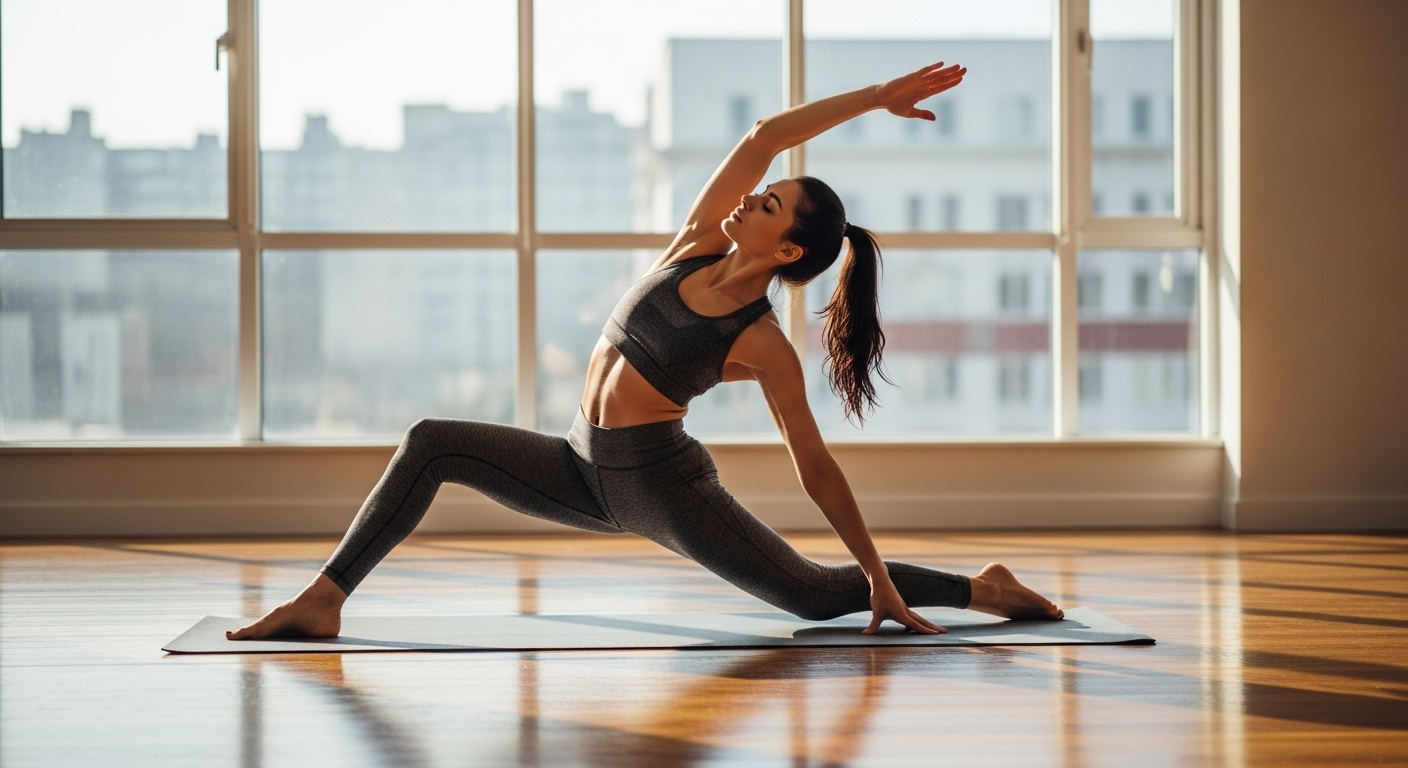
Yoga
Strength, Flexibility & Mindfulness in One Practice
Yoga is a holistic practice that combines physical postures, breathing techniques, and mindfulness to improve flexibility, strength, and mental clarity. It’s suitable for all fitness levels and can be adapted for relaxation or a challenging workout.
Benefits of Yoga
- ✅ Flexibility & Balance – Enhances posture and mobility
- ✅ Stress Relief – Promotes relaxation and reduces anxiety
- ✅ Strength – Builds core and full-body strength
- ✅ Breathing – Improves lung capacity and mindfulness
Beginner Yoga Flow (15–20 min)
- 📌 Mountain Pose – 30 sec deep breathing
- 📌 Downward Dog – 30 sec hold
- 📌 Cat-Cow – 6–8 slow reps
- 📌 Warrior II – 20 sec each side
- 📌 Tree Pose – 20 sec each side
- 📌 Child’s Pose – 1–2 min relaxation
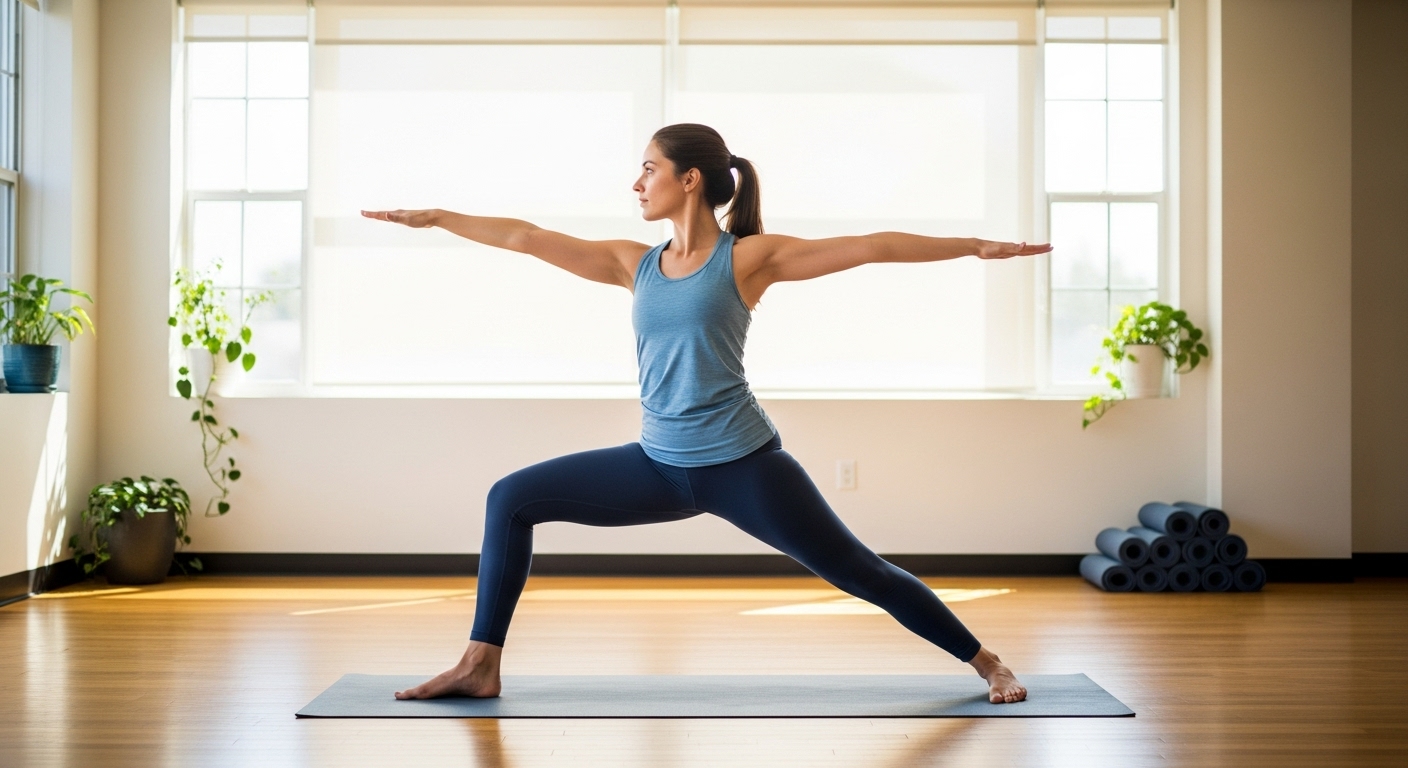
Goal-Based Workouts
Train With Purpose – Workouts Designed to Match Your Goals
Goal-based workouts focus your training efforts on achieving a specific fitness outcome, whether it’s losing fat, building muscle, or improving overall athletic performance. By aligning your workout plan with your goals, you’ll see results faster and stay motivated.
This category focuses on two main goals:
- ✅ Fat Loss – Combines cardio, strength, and nutrition to reduce body fat effectively.
- ✅ Muscle Gain – Focuses on progressive strength training to build lean mass.
Choosing the right plan for your goals ensures every workout moves you closer to your desired results while keeping training engaging and sustainable.
Step-by-Step Goal-Based Workout Plan
- 📌 Define Your Goal – Choose whether you want fat loss, muscle gain, or both.
- 📌 Fat Loss Focus – Include 3–5 cardio sessions per week + 2–3 strength training sessions.
- 📌 Muscle Gain Focus – Train each muscle group 2x/week with progressive overload.
- 📌 Nutrition Alignment – Eat in a calorie deficit for fat loss, surplus for muscle gain.
- 📌 Track Progress – Use body measurements, strength records, or photos.
- 📌 Stay Consistent – Results come from months of steady training and proper recovery.
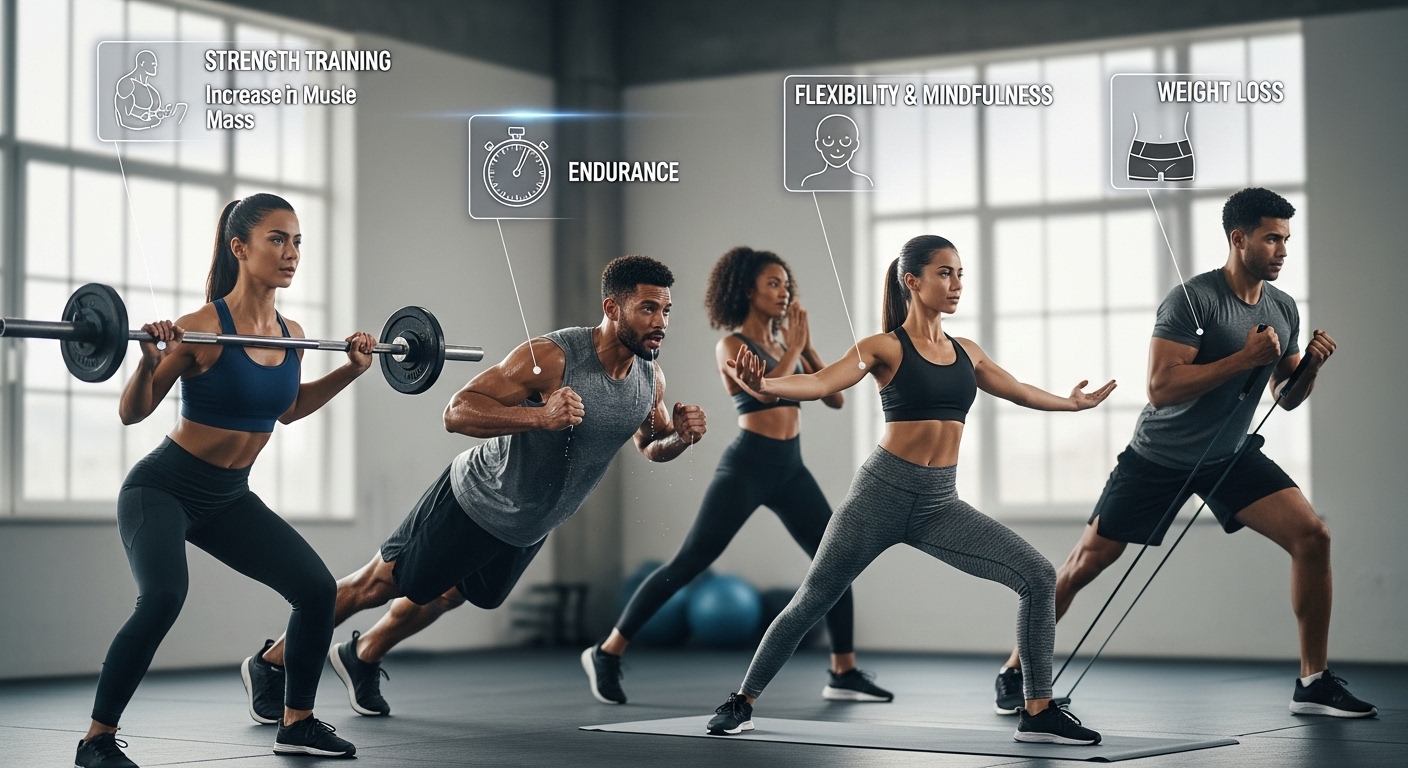
Fat Loss Workouts
Burn Calories, Boost Metabolism & Shed Excess Weight
Fat loss workouts combine strength training, cardio, and high-intensity intervals to burn calories efficiently and promote lean muscle growth. A smart fat loss program also includes proper nutrition and recovery for sustainable results.
Benefits of Fat Loss Training
- ✅ High Calorie Burn – Combines cardio and strength for maximum results
- ✅ Boosts Metabolism – Burns calories even after workouts
- ✅ Preserves Muscle – Focuses on fat loss, not just weight loss
- ✅ Improves Heart Health – Strengthens cardiovascular endurance
3-Day Fat Loss Workout Plan
- 📌 Warm-Up – 5 min light cardio (jog, jump rope)
- 📌 HIIT Session – 20 sec sprint / 40 sec walk × 8–10 rounds
- 📌 Strength Training – Circuit of squats, push-ups, and rows (3 rounds)
- 📌 Conditioning – Battle ropes, sled pushes, or kettlebell swings
- 📌 Cool Down – 5–10 min stretching for full body
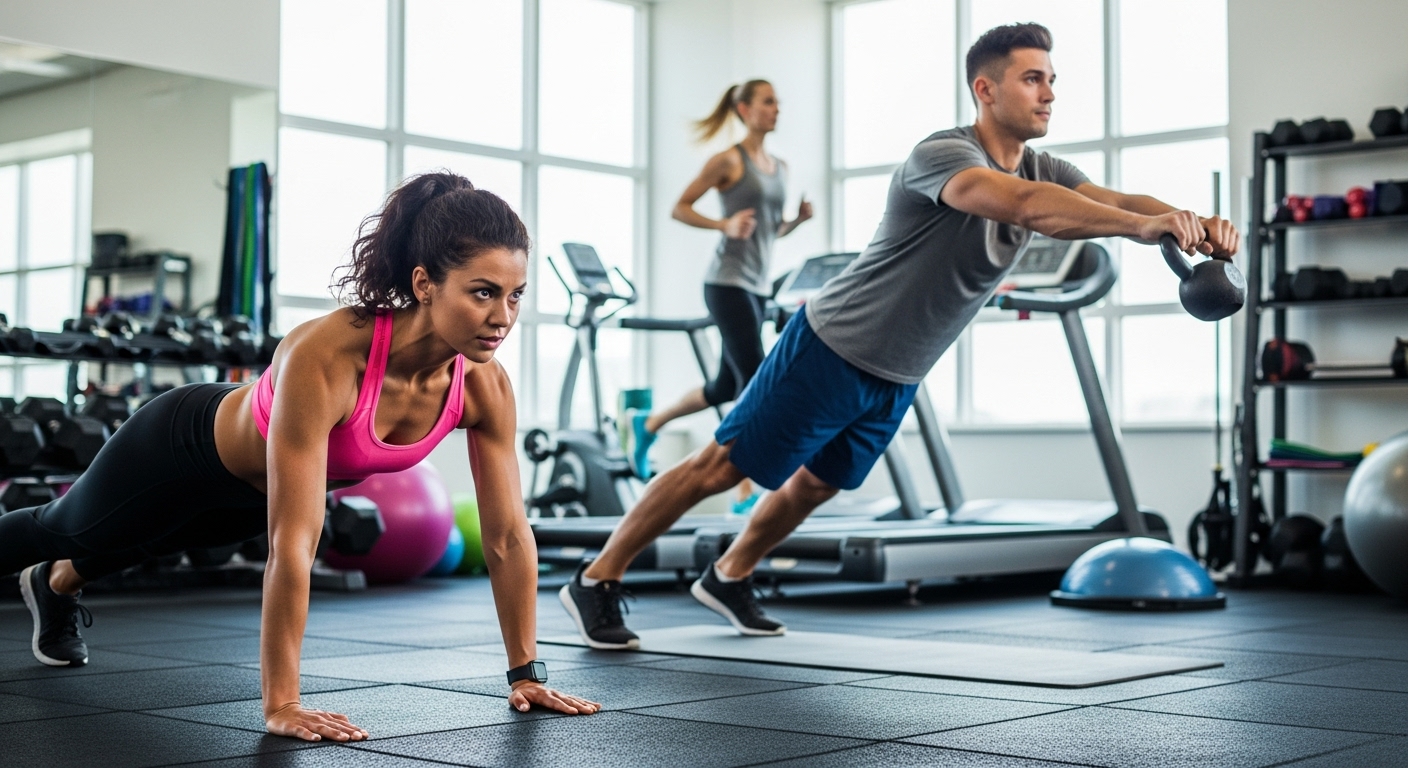
Muscle Gain Workouts
Build Strength, Size & Power with Progressive Training
Muscle gain workouts focus on progressive overload, compound lifts, and adequate recovery. They combine strength training with proper nutrition to stimulate muscle growth and increase overall strength.
Benefits of Muscle Gain Training
- ✅ Increased Muscle Mass – Builds lean muscle for strength and aesthetics
- ✅ Strength Boost – Improves power in daily activities and sports
- ✅ Higher Metabolism – Muscle burns more calories at rest
- ✅ Hormonal Health – Supports testosterone and growth hormone production
4-Day Muscle Gain Workout Plan
- 📌 Warm-Up – 5–7 min light cardio + dynamic stretching
- 📌 Progressive Overload – Increase weights weekly
- 📌 Day 1 & 3: Upper Body – Bench press, rows, shoulder press, pull-ups
- 📌 Day 2 & 4: Lower Body – Squats, deadlifts, lunges, calf raises
- 📌 Recovery – 48–72 hrs rest per muscle group
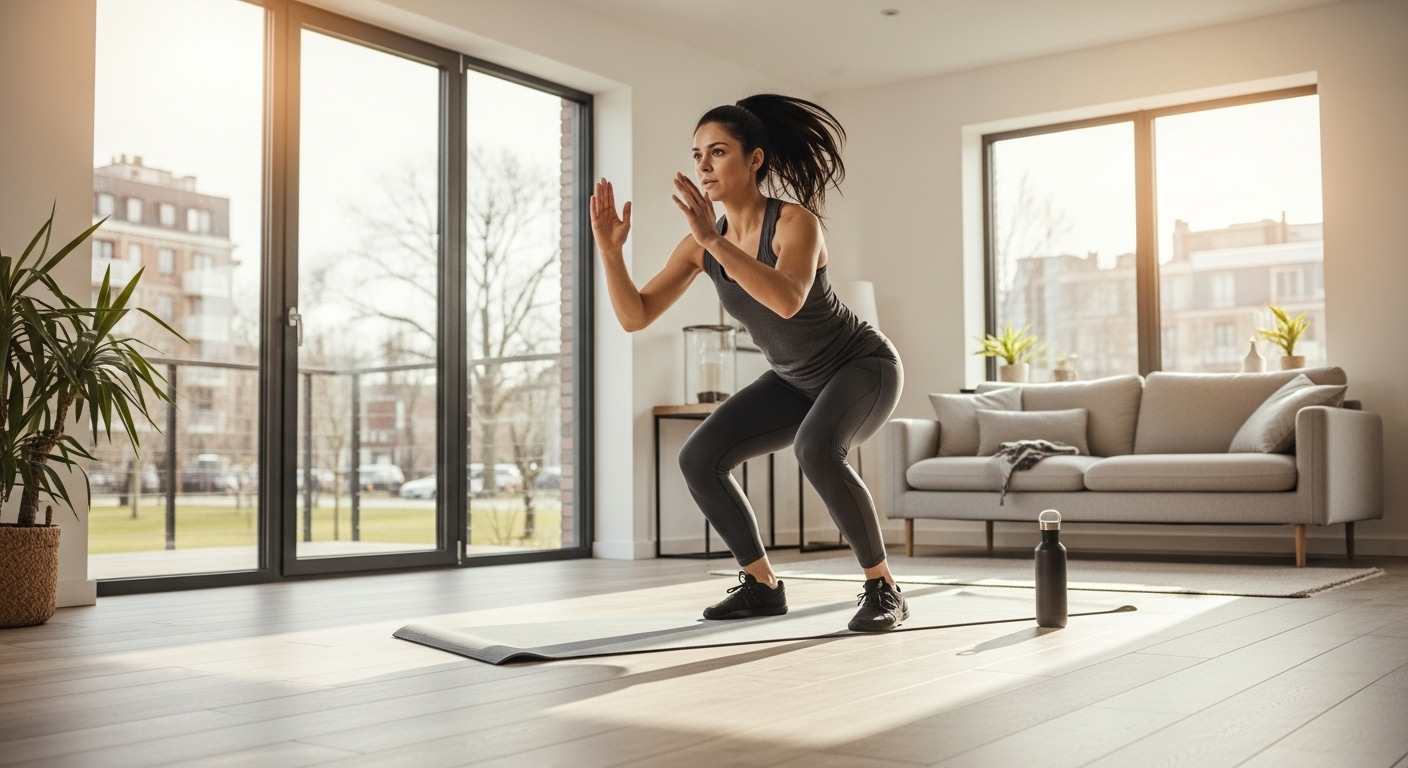
Home Workouts
Fitness Anytime, Anywhere – No Gym, No Excuses
Home workouts make it easy to stay active without the need for a gym membership or fancy equipment. With simple bodyweight exercises and short routines, you can build strength, improve endurance, and stay healthy from the comfort of your home.
This category focuses on:
- ✅ No Equipment – Use your own body weight for resistance.
- ✅ Quick Routines – Effective workouts in 10–20 minutes.
Perfect for busy schedules, home workouts help you stay consistent and fit, even with limited space and time.
Step-by-Step Home Workout Plan
- 📌 Warm-Up – 3–5 minutes of jumping jacks, high knees, or marching in place.
- 📌 Lower Body – Squats, lunges, calf raises (2–3 sets of 10–15 reps).
- 📌 Upper Body – Push-ups, tricep dips (use a chair), wall push-ups.
- 📌 Core – Planks, bicycle crunches, leg raises.
- 📌 Quick HIIT Option – 20 sec work / 10 sec rest for 4–5 exercises.
- 📌 Consistency – Aim for 3–5 sessions per week.
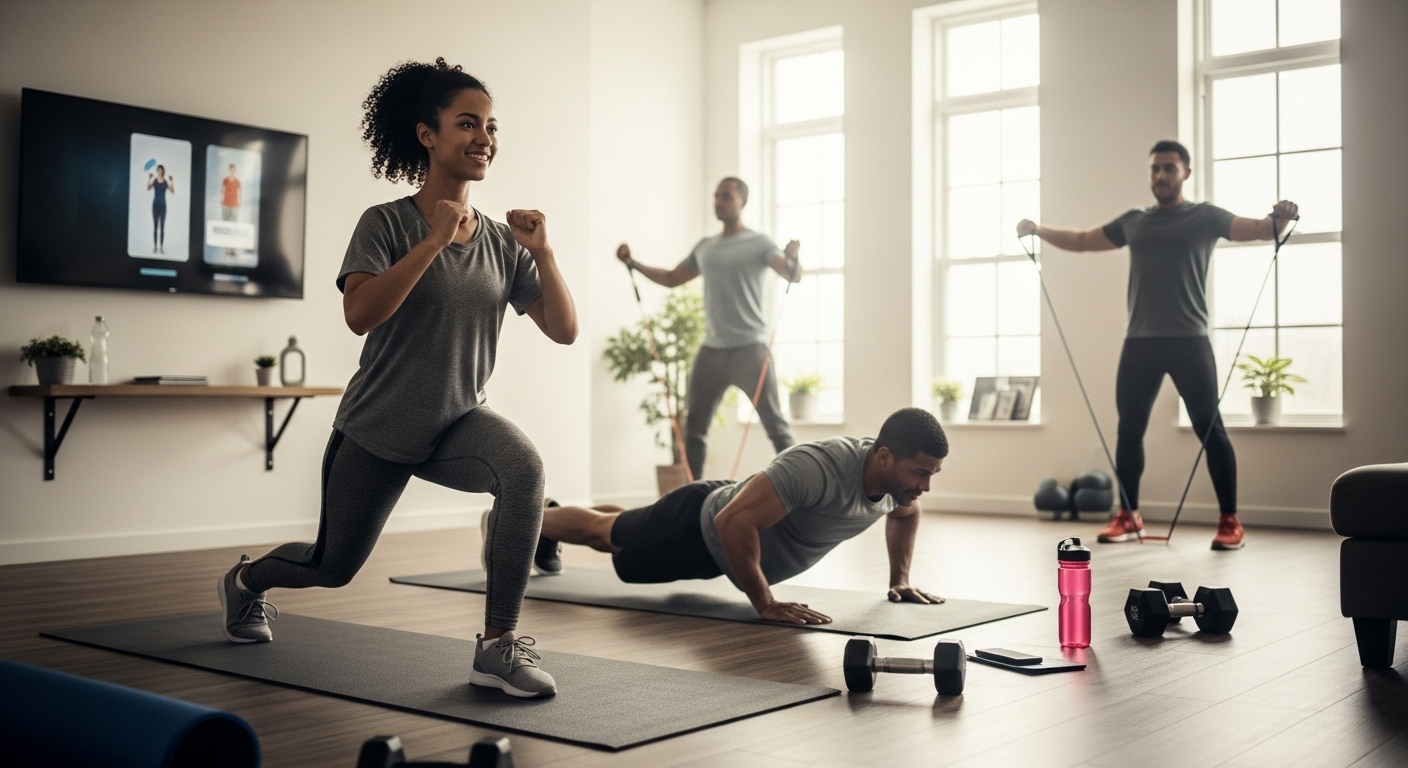
No Equipment Workouts
Get Fit Anywhere – No Gym, No Problem
No equipment workouts are perfect for home, travel, or outdoor training. Using your body weight for resistance, these exercises can build strength, improve endurance, and burn calories without needing a single piece of gym equipment.
Benefits of No Equipment Training
- ✅ Convenience – Train anytime, anywhere
- ✅ Cost-Free – No need for expensive gym memberships
- ✅ Effective – Builds strength and burns fat with functional moves
- ✅ Safe & Adaptable – Suitable for all fitness levels
20-Minute No Equipment Workout
- 📌 Warm-Up – 3–5 min jumping jacks, high knees
- 📌 Push-Ups – 3 sets of 10–15 reps
- 📌 Bodyweight Squats – 3 sets of 15–20 reps
- 📌 Mountain Climbers – 3 sets of 20–30 sec
- 📌 Plank Hold – 3 sets of 20–40 sec
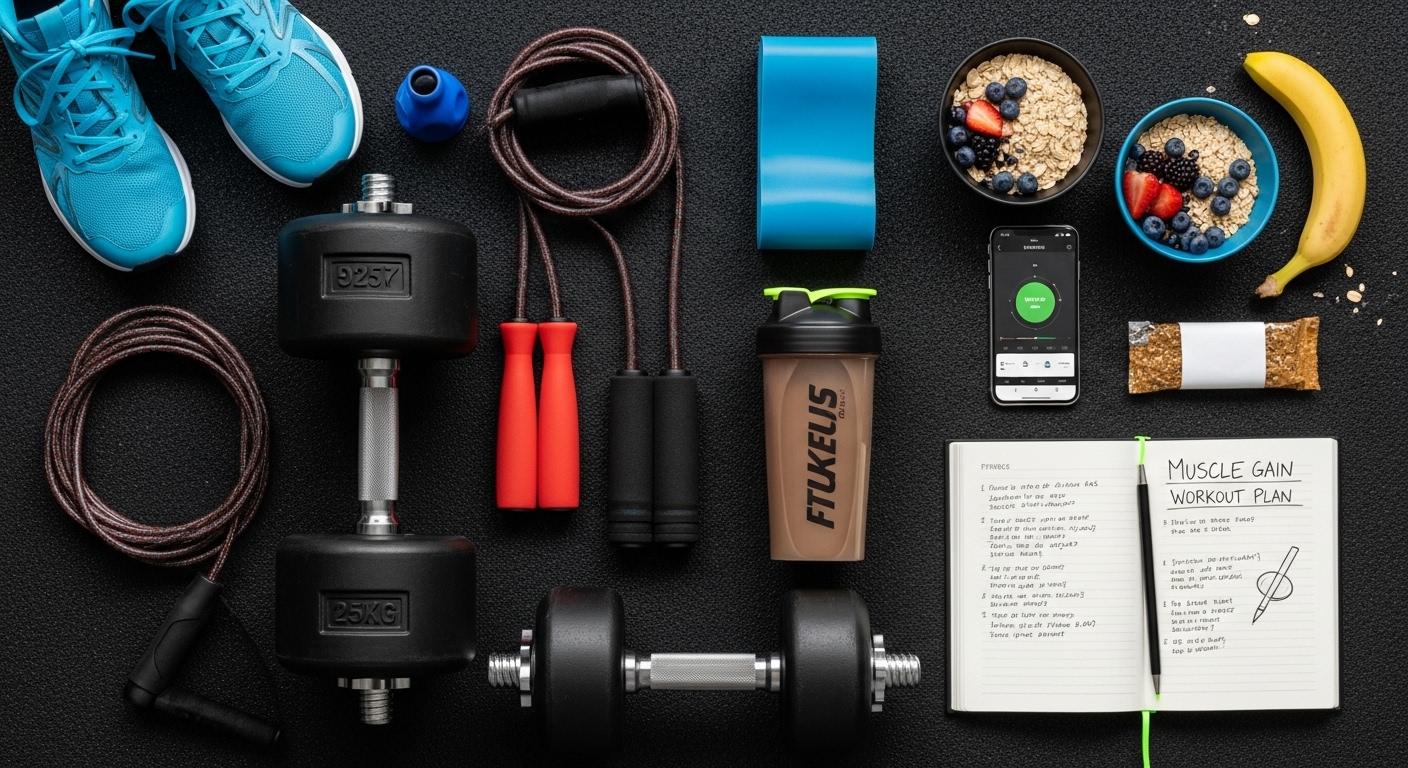
Quick Routines
Fast, Effective Workouts for Busy Days
Quick workout routines are perfect for busy schedules. They’re short but effective, combining strength and cardio to give you a full-body workout in 10–20 minutes. No excuses – you can fit these in before work, during lunch, or in the evening.
Benefits of Quick Workouts
- ✅ Time-Efficient – Get results in just 10–20 minutes
- ✅ Calorie Burn – Boosts metabolism quickly
- ✅ Full-Body Training – Works multiple muscle groups
- ✅ Flexible – Can be done at home, office, or gym
15-Minute Full-Body Quick Routine
- 📌 Warm-Up – 2 min jumping jacks, arm circles
- 📌 Squats – 1 min at steady pace
- 📌 Push-Ups – 1 min continuous
- 📌 Mountain Climbers – 30 sec fast pace
- 📌 Plank – 30 sec hold
- 📌 Cool Down – 2 min stretching

Recovery – Rest Days & Injury Prevention
Recharge Your Body, Protect Your Progress
Recovery is just as important as your workouts. Your muscles grow, repair, and get stronger when you rest — not when you train. Proper recovery reduces the risk of injury, prevents burnout, and keeps you motivated to keep moving.
Effective recovery focuses on:
- ✅ Rest Days – Take 1–2 days off per week to allow your body to recover.
- ✅ Mobility Work – Gentle stretching and foam rolling to ease stiffness.
- ✅ Injury Prevention – Warm up before exercise, use correct form, and progress gradually.
Remember: Rest is not laziness — it’s an essential part of becoming fitter, stronger, and healthier.
Step-by-Step Recovery Routine
- 📌 Prioritize Sleep – Get 7–9 hours each night for optimal recovery.
- 📌 Stay Hydrated – Water supports nutrient transport and muscle repair.
- 📌 Eat for Recovery – Include protein, healthy fats, and complex carbs in meals.
- 📌 Stretch & Mobilize – Gentle yoga or stretching after workouts.
- 📌 Prevent Overtraining – Listen to your body, and adjust intensity when needed.
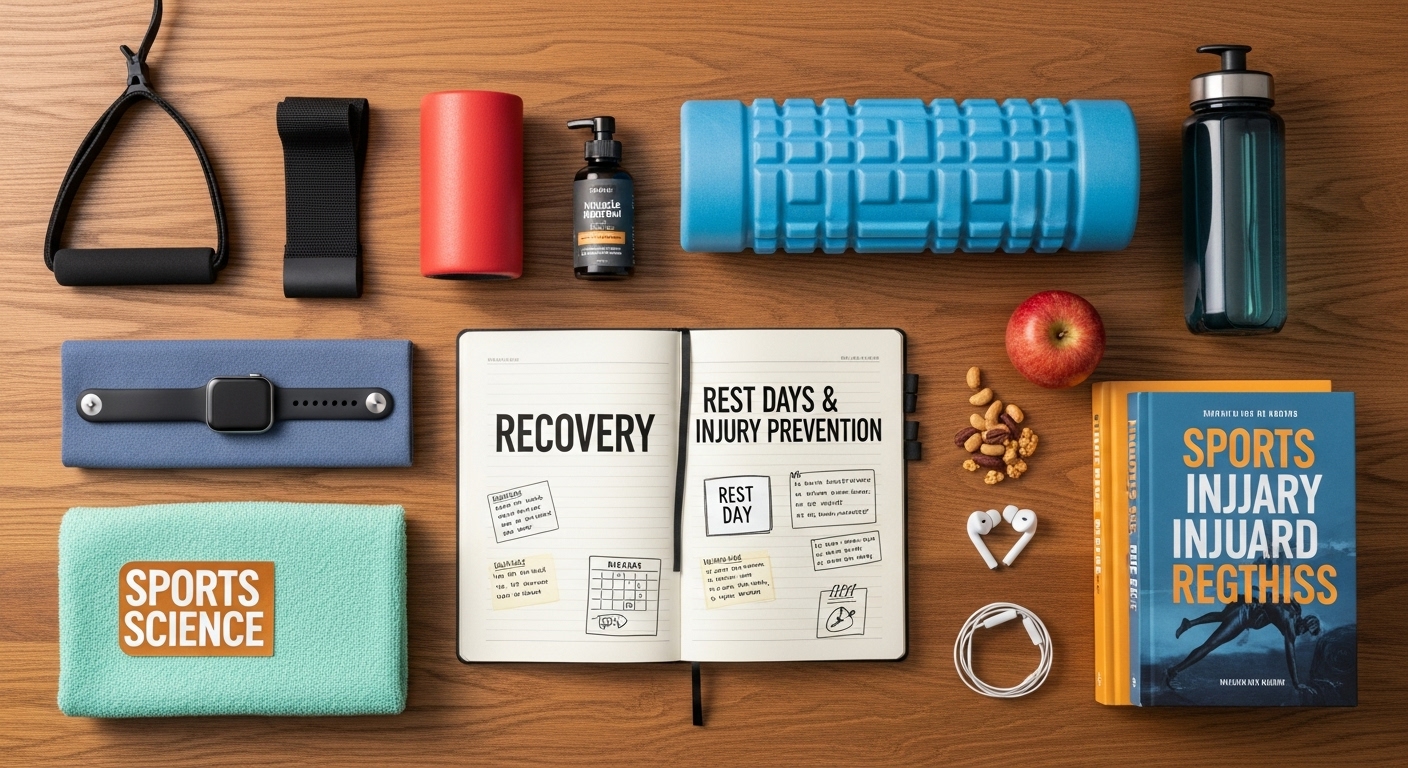
Rest Days
Recharge Your Body, Boost Your Performance
Rest days are an essential part of any fitness plan. They give your muscles, joints, and nervous system time to recover, repair, and grow stronger. Skipping rest can lead to fatigue, injuries, and stalled progress.
Benefits of Taking Rest Days
- ✅ Muscle Recovery – Repairs micro-tears in muscles after workouts
- ✅ Prevents Overtraining – Avoids fatigue and burnout
- ✅ Supports Heart Health – Reduces stress on the cardiovascular system
- ✅ Mental Reset – Improves focus and motivation for future workouts
How to Use Rest Days Effectively
- 📌 Sleep Well – Aim for 7–9 hours per night
- 📌 Eat Nutritious Foods – Support recovery with protein, fruits, and veggies
- 📌 Stay Hydrated – Keep your body functioning at its best
- 📌 Light Activity – Gentle walks or stretching to keep blood flowing

Injury Prevention
Train Smart, Stay Strong & Avoid Setbacks
Preventing injuries is just as important as building strength and endurance. By following proper form, warming up, and listening to your body, you can keep your training safe, effective, and consistent.
Benefits of Injury Prevention
- ✅ Avoids Setbacks – Keeps you progressing without breaks
- ✅ Better Performance – Healthy joints & muscles work more efficiently
- ✅ Long-Term Health – Protects your body for years of training
- ✅ Increased Mobility – Improves flexibility and reduces strain
Key Injury Prevention Strategies
- 📌 Warm-Up First – 5–10 min of light cardio and mobility drills
- 📌 Use Proper Form – Focus on technique over heavy weights
- 📌 Schedule Rest – Avoid training the same muscle group every day
- 📌 Hydrate & Fuel – Keep joints lubricated and muscles nourished
- 📌 Listen to Your Body – Stop if you feel pain, not just discomfort
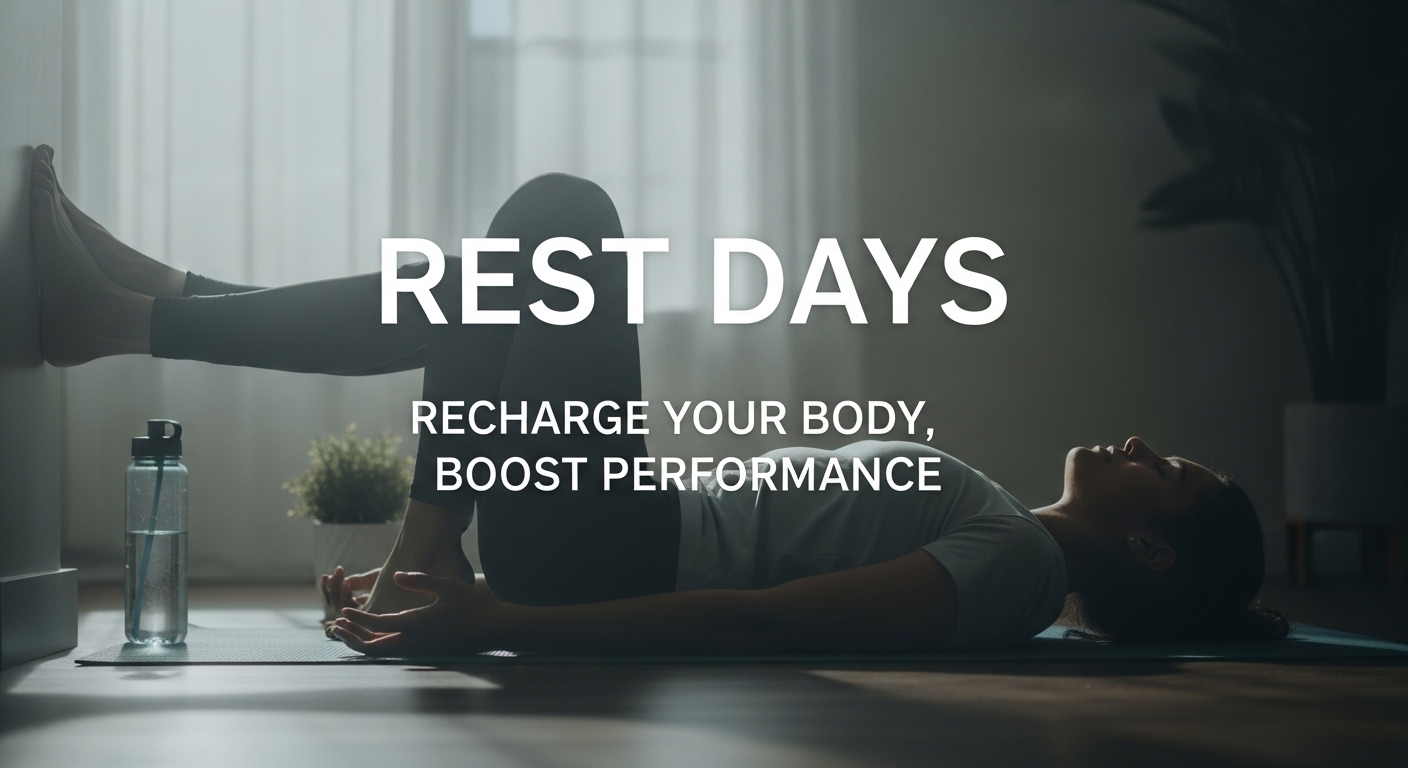
Advanced Training
Push Your Limits – For Experienced and Dedicated Fitness Enthusiasts
Advanced training is designed for those who already have a solid fitness foundation and want to take their performance, strength, and conditioning to the next level. These workouts are more intense, structured, and physically demanding.
This category focuses on:
- ✅ Split Routines – Target specific muscle groups on different days for maximum growth.
- ✅ CrossFit – High-intensity functional training that builds strength, power, and endurance.
These programs demand proper technique, disciplined recovery, and a commitment to pushing your limits while avoiding overtraining.
Step-by-Step Advanced Training Plan
- 📌 Training Schedule – Plan 4–6 workout days per week.
- 📌 Split Routine Example – Day 1: Chest/Triceps, Day 2: Back/Biceps, Day 3: Legs, Day 4: Shoulders/Core.
- 📌 CrossFit WODs – Perform daily high-intensity functional workouts combining strength, cardio, and mobility.
- 📌 Progressive Overload – Increase weight, reps, or intensity over time.
- 📌 Nutrition & Recovery – Support training with a high-quality diet and 7–9 hours of sleep.
- 📌 Injury Prevention – Warm up thoroughly, use correct form, and include mobility work.
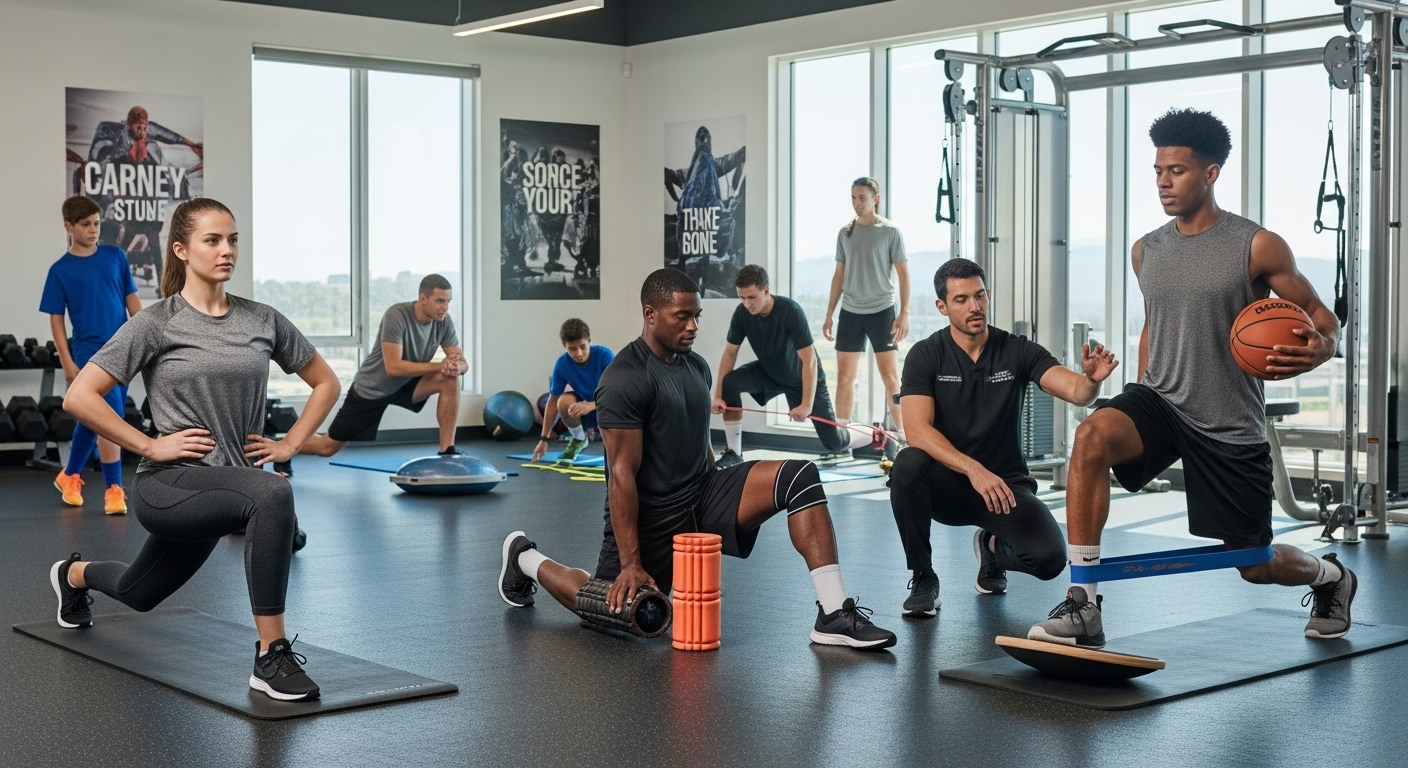
Split Routines
Target Specific Muscle Groups for Maximum Gains
Split routines divide your workouts by muscle group or movement type, allowing you to train each area with higher intensity and volume. This method is ideal for intermediate to advanced lifters aiming for muscle growth and strength.
Benefits of Split Training
- ✅ Focused Work – More sets and reps per muscle group
- ✅ Higher Intensity – Push each muscle group harder
- ✅ Better Progress – Optimized for hypertrophy and strength
- ✅ Recovery Time – Allows muscles to rest before hitting them again
Example 5-Day Split Routine
- 📌 Day 1: Chest & Triceps – Bench press, dips, tricep pushdowns
- 📌 Day 2: Back & Biceps – Pull-ups, rows, bicep curls
- 📌 Day 3: Legs – Squats, lunges, hamstring curls
- 📌 Day 4: Shoulders & Abs – Shoulder press, lateral raises, planks
- 📌 Day 5: Full Body or Weak Point Training – Mix of compound and isolation moves
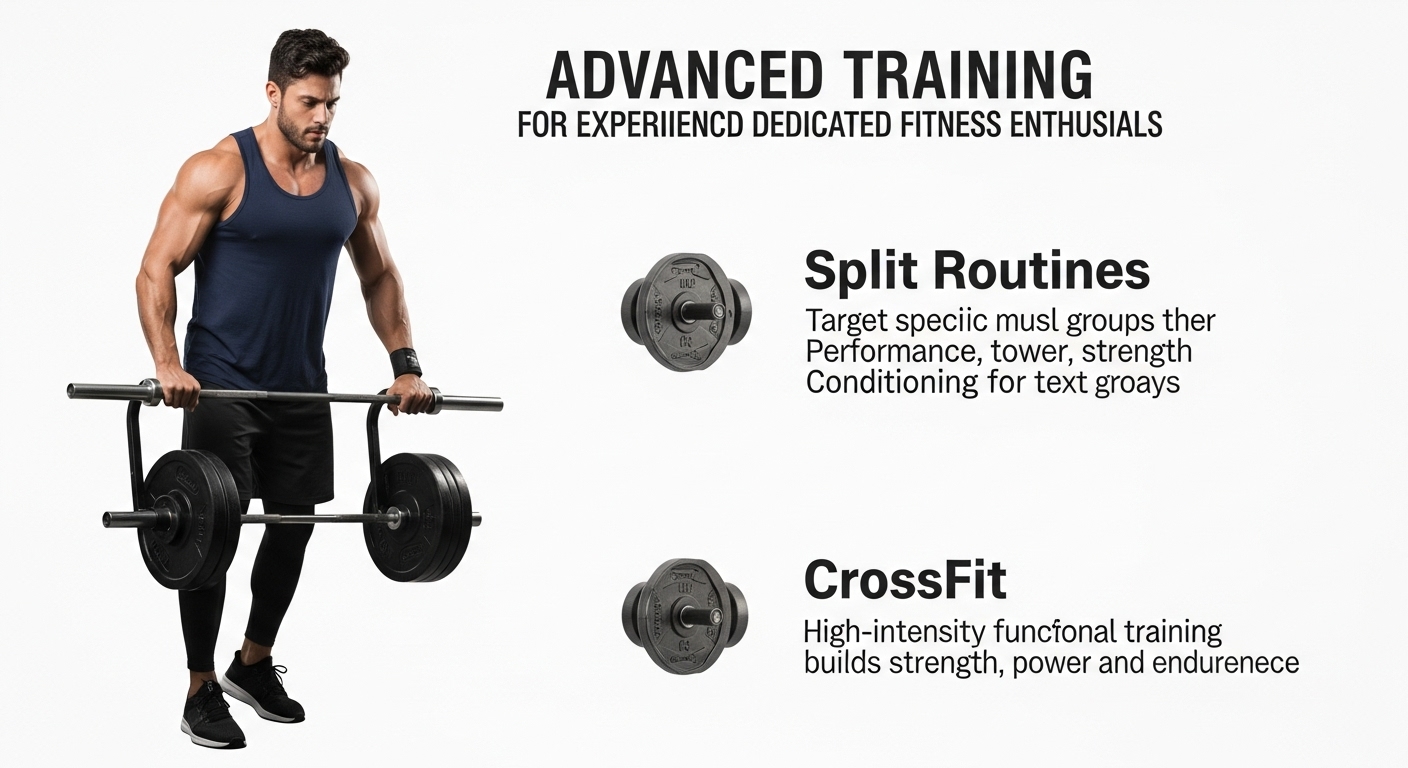
CrossFit
High-Intensity Functional Fitness for Strength & Endurance
CrossFit is a high-intensity training program that blends strength, cardio, and functional movements. It’s designed to improve overall fitness by challenging multiple muscle groups and energy systems in short, intense sessions.
Benefits of CrossFit
- ✅ High Calorie Burn – Burns fat and builds strength quickly
- ✅ Strength & Conditioning – Improves power and muscular endurance
- ✅ Cardiovascular Health – Boosts heart and lung capacity
- ✅ Community Motivation – Group workouts keep you accountable
Example CrossFit WOD (Workout of the Day)
- 📌 Warm-Up – 5 min rowing or jump rope
- 📌 Strength – 5x5 back squats
- 📌 Metcon – AMRAP 12 min: 10 push-ups, 15 kettlebell swings, 200m run
- 📌 Cool Down – Stretching & foam rolling
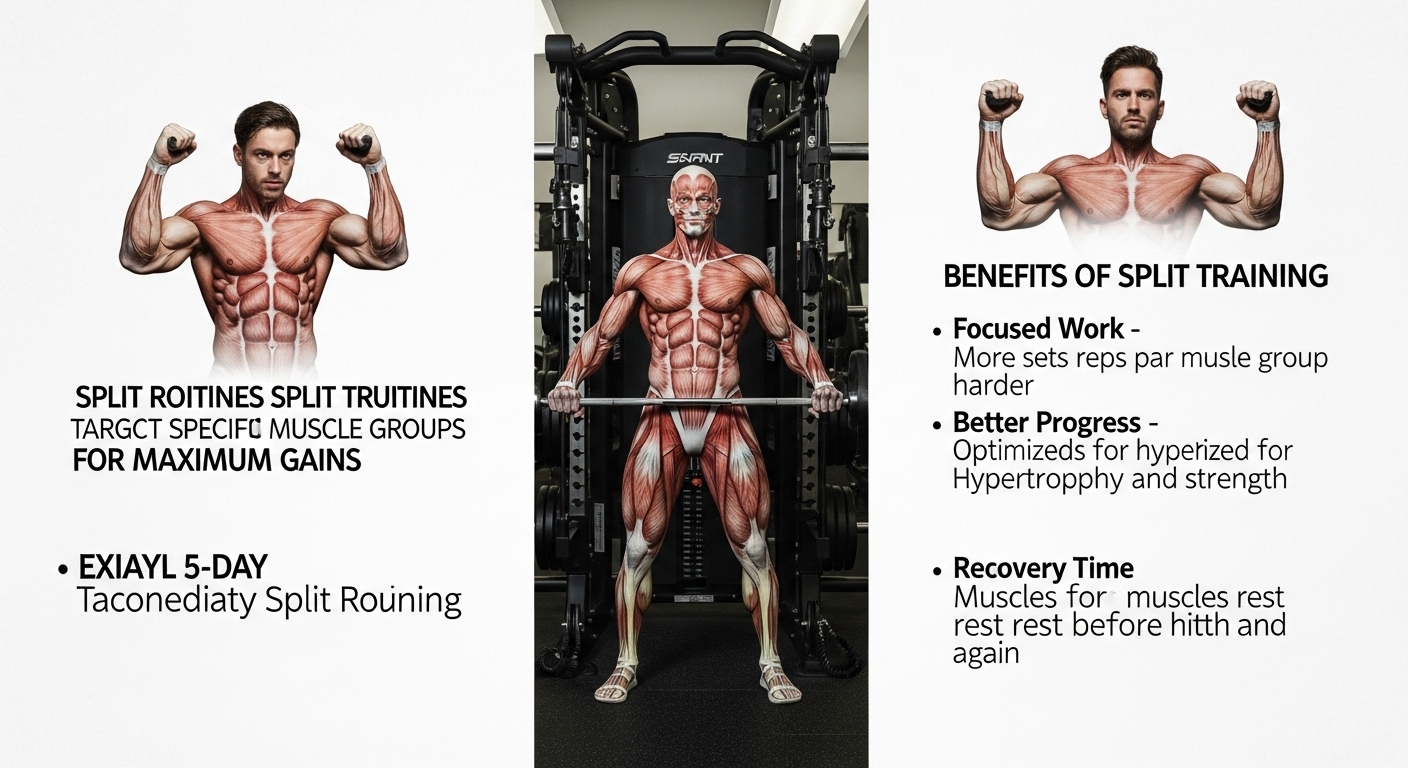
Workout Guidance – FAQ
Common Questions Answered to Help You Train Smarter
